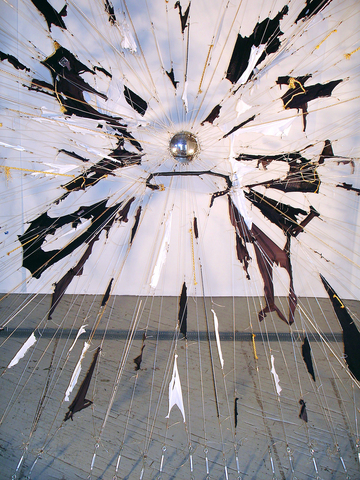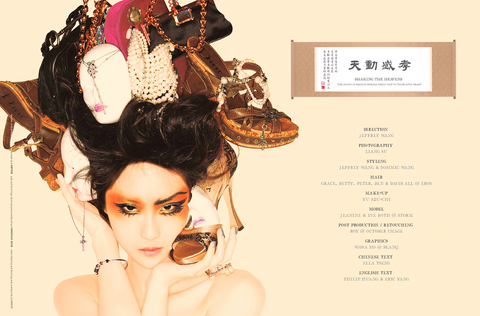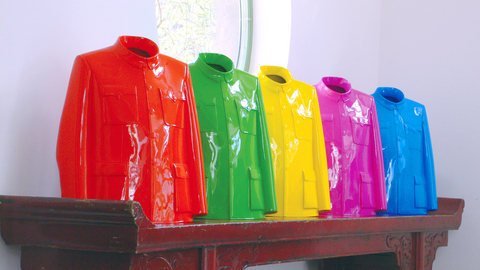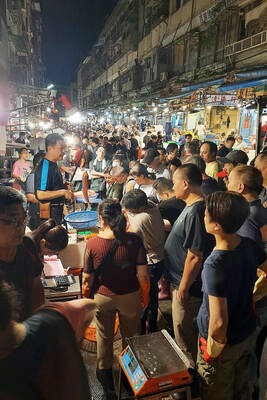New York's Guggenheim Museum mounted an exhibition in 1997 titled Fashion/Art, which examined the relationship between art and fashion in the 20th century.
That exhibit revealed how certain early 20th century art movements, such as Italian Futurism and Russian Constructivism, combined fashion with art as a means of complimenting their notions of a utopian society. By the mid-century, the distance between art and fashion were narrowed as Pop art merged the two in a conscious effort to erase the distance between high and low art. Since the 1960s, various artists have sought to undermine the fashion world's pretension to elegance by drawing attention to the industry's underbelly.
Sean Hu (胡朝聖), curator of MOCA's current exhibit titled Fashion Accidentally saw the Guggenheim exhibit and was inspired by the ideas expressed in the highly regarded show.

PHOTOS: COURTESY OF MOFA, TAIPEI
"Since then I have been collecting information related to clothing to find a context for this exhibition," he said after the exhibit's opening reception.
"I want to discuss this issue through semiology, sociology, psychology and also feminism ... and ... through clothing, respond to what is going on in our world, to what is happening at this moment."
Bringing together the work of 15 young artists from around the globe whose work covers a variety of media, the show is presented thematically and employs a political and humorous visual language that makes it accessible, though with enough resonance to appeal to those well-versed in critical theory.

Illustrating the relationship between feminine ideals and fashion is Jeffrey Wang's (王九思) witty 24 Xiao (二 十 四孝), a series of exquisitely rendered c-print posters that appropriate the traditional Chinese concept of filial piety. Taking idealized notions of how women should look, the artist fuses each image with objects of desire. The images are both decadent and banal in their use of symbols, and the artist employs a satirical visual language that is at once low and highbrow.
The commodification of Western images and their onslaught on Asian culture is humorously portrayed by Yasumasa Morimuras' series of large photos called Self-Portrait (Actress). The Japanese artist photographed himself dressed up as famous female movie stars, which effectively demonstrates the bizarre nature of gender issues and the often unspoken cultural hegemony that this entails. The artist has deliberately left obvious flaws in the pictures.
Humanity's cruelty and disrespect for life are the themes of Nicola Costantino's Human Furrier, where skin-like fabric and human hair are used to create a fictitious line of clothing that draws attention to our obsession with satisfying cravings for clothing. Taking a different approach with her line of fashion, Taiwan-based, American artist Susan Kendzulak explores relationships between humans in her installation Love/Hate. Juxtaposing her line of conjoined knitted apparel with a boxing ring shows how love is a messy, complex and intimate affair.

E.V. Day's installation titled Chanel/Shazam explodes — literally — a garment of Chanel clothing and then suspends the cotton shrapnel from fish wire. Harking back to 1960s and 1970s feminist thought, in which clothing is intimately tied up with freedom and subjugation, Day's work menacingly illustrates the predicament still faced by today's women.
Chinese artist Sui Jian-guo's (隋建國) sculpture titled Rainbow Jacket blends Sun Yat-sen's (孫中山) drab tunic suit — often misinterpreted as those worn by Mao Tse-tung (毛澤東) — with the psychedelic cover art of the Beatles' Sergeant Pepper album, and brings to light the ways in which China is both steeped in the past and opening to Western influences.
Harking back to 1990s militant political art, though still eminently topical, is Venezuelan artist Jose Antonio Hernandez-Diez' My Fucking Jeans, one of four installations that examines the relationship between highly paid designers and the cheap overseas labor that turns the images into products — items that the laborers themselves couldn't possibly afford.

Though the show has its roots in fashion history and serious political activism, it is more than a didactic exhibition and takes a humorous look at the accidents the world of fashion continues to make.


The Taipei Times last week reported that the rising share of seniors in the population is reshaping the nation’s housing markets. According to data from the Ministry of the Interior, about 850,000 residences were occupied by elderly people in the first quarter, including 655,000 that housed only one resident. H&B Realty chief researcher Jessica Hsu (徐佳馨), quoted in the article, said that there is rising demand for elderly-friendly housing, including units with elevators, barrier-free layouts and proximity to healthcare services. Hsu and others cited in the article highlighted the changing family residential dynamics, as children no longer live with parents,

It is jarring how differently Taiwan’s politics is portrayed in the international press compared to the local Chinese-language press. Viewed from abroad, Taiwan is seen as a geopolitical hotspot, or “The Most Dangerous Place on Earth,” as the Economist once blazoned across their cover. Meanwhile, tasked with facing down those existential threats, Taiwan’s leaders are dying their hair pink. These include former president Tsai Ing-wen (蔡英文), Vice President Hsiao Bi-khim (蕭美琴) and Kaohsiung Mayor Chen Chi-mai (陳其邁), among others. They are demonstrating what big fans they are of South Korean K-pop sensations Blackpink ahead of their concerts this weekend in Kaohsiung.

Taiwan is one of the world’s greatest per-capita consumers of seafood. Whereas the average human is thought to eat around 20kg of seafood per year, each Taiwanese gets through 27kg to 35kg of ocean delicacies annually, depending on which source you find most credible. Given the ubiquity of dishes like oyster omelet (蚵仔煎) and milkfish soup (虱目魚湯), the higher estimate may well be correct. By global standards, let alone local consumption patterns, I’m not much of a seafood fan. It’s not just a matter of taste, although that’s part of it. What I’ve read about the environmental impact of the

Oct 20 to Oct 26 After a day of fighting, the Japanese Army’s Second Division was resting when a curious delegation of two Scotsmen and 19 Taiwanese approached their camp. It was Oct. 20, 1895, and the troops had reached Taiye Village (太爺庄) in today’s Hunei District (湖內), Kaohsiung, just 10km away from their final target of Tainan. Led by Presbyterian missionaries Thomas Barclay and Duncan Ferguson, the group informed the Japanese that resistance leader Liu Yung-fu (劉永福) had fled to China the previous night, leaving his Black Flag Army fighters behind and the city in chaos. On behalf of the